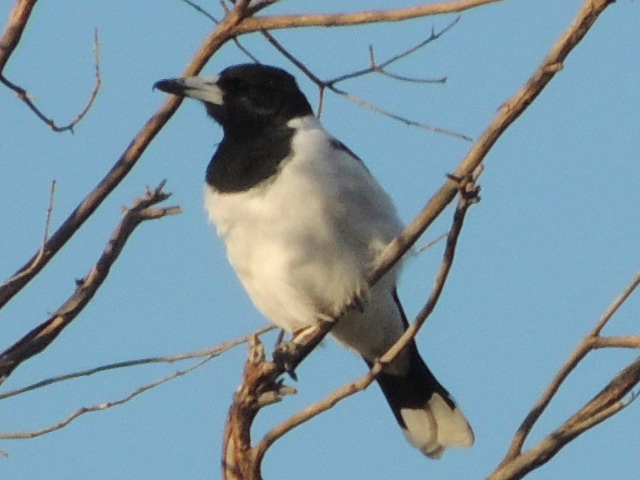I have called this week's SoS 'Garden Visitors Three' because I've previously posted Garden Visitors and Garden Visitors Two, so the title of this post seems to be quite pertinent. We have recently had a number of really delightful guests in the garden. I wish they would become permanent residents, but perhaps because there isn't really a canopy as yet, their sojourns are fleeting; a hasty stop before flitting off elsewhere. They are visitors of the feathered variety, of course, but because I had a lot of difficulty photographing them without a telephoto lens, the photos aren't the best quality.

1. A male King Parrot. These large parrots can become quite tame and will eat food from a person's hand. In our town they're almost at the most western limit of their distribution. He is quite resplendent in his suit of scarlet and green, and he has a a blue tail, which doesn't feature very well from this angle.

2.A female King Parrot, looking a little ruffled: she might have spotted me loitering. These parrots mate for life and can always be seen as a couple. They communicate with each other by emitting sweet whistles.

3. A male Superb Fairy Wren. He isn't monogamous at all and can be seen darting through the shrubbery with his harem of females, communicating with them with silvery calls. A fairy wren is tiny and weighs on average 10 grams. These little birds like dense foliage to keep them safe from predators: he'd be rather prominent with his bright, almost irridescent blue livery.

4. Here's one of his wives. She's quite dowdy in comparison, but very sweet nevertheless. These birds are one of Australia's favourites. It was really difficult to get a clear photo of the wrens because they're never still for more than a second as they dart hither and thither searching for insects.

5. This handsome bird in his dinner suit is a Butcherbird. I'm not able to identify it specifically, because I can't see enough of it and there are several different varieties. Butcherbirds have earned their name because of their habit of wedging animal bodies (lizards, other smaller birds or mice) into the fork of a tree, or impaling them on a broken branch (just like a butcher hanging a carcass ) before tearing them into smaller pieces. Look at that beak! Just made for carnage. One of those little wrens would make a perfect meal if it wasn't hidden away in my shrubbery! Butcherbirds are friendly to humans however (except during nesting time), and can be tamed. A redeeming feature is their call, a variety of sounds, but often a glorious, perfectly pitched sequence of notes in the cool Autumn morning air. They are related to Australian magpies and like them, are clever at mimicking other birds and animals.
You can hear an example of the Butcherbird's song here

6. White Cheeked (or eastern) Rosella. This Rosella often uses one of its feet, usually the right foot, to hold food when eating on the ground or perched on a tree. Right-handed Rosellas, who would have thought it! They eat seeds, fruits and nectar. They also, like most parrots, mate for life. This one is a male.
I hope that when the canopy in my garden becomes thicker, more of these birds will come to stay.
Thanks to The Propagator for hosting the Six on Saturday meme. Don't forget to go on over to his site to see what other gardeners are doing this week.
Weather today: Sunny, 13-31 C
These are wonderful! I do remember once being visited in my garden in Sydney by a male and female king parrot and they were just stunning. My dad loves eastern rosellas, but my favourites were the crimson rosellas. The fairy wren is wonderful! I don’t remember seeing any of those. And that is so deliciously grizzly about the butcherbird!
Thanks, Ali. I’m with you on the crimson rosellas, but they don’t often come this far west, sadly.
These are delightful. Wonderful bursts are colour in the garden. The fairy Wren is a big change from our UK little dowdy thing.
Thank you for visiting. Yes, the birds are charming and I love to see them in the garden.
Beautiful photos. We have these birds in our garden too. I love to hear their calls.
Thanks for visiting Trish. These birds are a joy to have in the garden.
Hi Jane, lovely to see the birds in your garden. You must be thrilled.
In our part of the world, we are very fortunate to have lots of Crimsons and Eastern Rosellas visit our garden, albeit they stick mostly to the front garden. That might have something to do the canary seed leftovers that I toss out every couple of days. We get the occasional King Parrot but they are infrequent visitors. We see very few fairy wrens, even though I hear them from time to time. I suspect they are put off by our dogs. I’ve rarely seen the Butcher birds, but for some reason, I’ve seen several this year. My lads think your’s is a Pied Butcher Bird.
Cheers, Tracy.
Oh thanks Tracy. I thought perhaps a pied, but wasn’t completely sure.
Very beautiful colors of these birds ..! We don’t have them like that here. It changes flowers, shrubs and trees … thank you!
Thank you, Fred. they are a joy, and very special to have in one’s garden.
How beautiful, and somewhat surreal (and marvelous) for me to see parrots in the wild!
There are lots of them Lyn, and they give so much pleasure!
I love visiting birds in the garden. Of course ours are no where near as colourful as yours are, but if you look closely we do have some pretty ones – blue-tits, great-tits, chaffinch, greenfinch, bullfinch, goldcrest – and even the ‘black’ birds often have iridescent feathers of blue and green. I was very lucky to get several photos of fairy wrens when last in your country. I think they are so pretty, though I do like our own little brown wren with its cocked up tail.
Yes you do have some beautiful birds too, Jude. I especially like the way British birds sing in the mornings: it’s a lovely sound. Some of our birds eg galahs and cockatoos, can be very squawky!
What gorgeous colourful birds. Lovely pictures.
Bright birds! Resident at the moment are robins, sparrows, tits, regular stuff for the UK. There’s an owl somewhere, i can hear it but have never seen it.
‘Regular’ birds are rather special too. I think robins are particularly attractive.
What incredible birds you have in Australia. I particularly like your fairy wren. Is it related to the British wren which is quite common but rarely seen as it is so tiny and fast?
Surprisingly, Ciar, they are not related, though they do seem to be of a similar size to yours, and to also have the erect tail.
What an amazing show! Such a treat to see these wonderful birds. Thanks for sharing 🙂
Thanks for visiting Gill, I’m happy you enjoyed the birds.
Love to see the birds in the garden. Well done catching the wren, they flit around so quickly. Lots of them down on the beach front, but I can never get a photo of them. I used to have all the parrots visiting, but now the noisy miners have taken over and, sadly, chased everything, except the butcher birds, away
Thanks Pauline. Those noisy miners are nasty birds, going around in gangs the way they do, we have them too.
Lovely Jane, as your garden matures you will see more and more of those lovely feathered creatures.
Thanks Marg, I one day hope to have as many king parrots as you!
What a great series of bird species, Jane, (and of course I know too well how hard it is to photograph a Fairy-wren).
Hopefully, as your garden expands, some will visit more often. I’m beginning to think a home garden is the easiest way to photograph our birds as they get used to seeing humans around.
I photographed a soft aqua blue bird on the other side of my road yesterday and I still can’t find out what it is. I’ve been through my Australian Bird Guide book twice and all the Australian bird websites trying to find its name. I wonder if its some sort of hybrid OR a bird escaped from a home aviary of a collector. My images are a bit soft in focus being so far away and a hand-held shot.
Hi Vicki, thanks for your comments. What you might need is an app that identifies birds. I just found this online http://earthsky.org/earth/app-identifies-birds-photos-merlin. Perhaps it might help. I know there’s one for plants. Whether that app works on a not very clear picture, I don’t know, but you could give it a try.
Loved the butcher bird duet.
They’re fun aren’t they, and very tame.
Jane, these pictures are beautiful! My garden is often visited by parrots but they are not as colorful as their australian cousins!
Hello Marcelo, I’m glad you enjoyed the photos. Hope you’re getting some rain over there.
On average, the birds in your part of the world are so much more colorful than those we commonly see here in coastal Southern California. We do have wild parrots, as well as wild parakeets, but they didn’t come here of their own volition – they’re the progeny of pets that escaped and have spread. You usually don’t see them as much as hear them as they generally travel in packs, focused on food sources like date palms. The most common year-round avian residents in my garden are finches, hummingbirds, and scrub jays.
Hummingbirds are so beautiful, Kris, and I imagine would be very difficult to photograph. For millennia, birds in Australia had no predators and no need for camouflage. Later European settlers systematically cleared the land and introduced cats and foxes so many of our birds are now endangered. Some, such as the rainbow lorikeets, seem to co-exist with humans very happily.
Such beautiful birds – they make the sparrows and wrens that we get in the garden here look very brown and boring!
We have brown birds too!
Thanks for sharing your exotic visitors.
I’m glad you enjoyed them Christina.
I like your photos – even without telephoto – and your captions. Thanks for finding me. Following reciprocated
Thank you for following me Derrick!
I’ve so enjoyed seeing your birds, Jane! That’s one of the special things about having a garden, I think – seeing the birds and lizards and such (rabbits excepted!) turn it into a home or at least a place to pause as they pass through. I’m always a bit envious of my Australian friends for having all those magnificent parrots in their gardens! 😉
Thank you, Amy, I’m happy you enjoyed the birds. The parrots are really beautiful and it’s thrilling when they arrive for a visit.
NICE BIRDS!